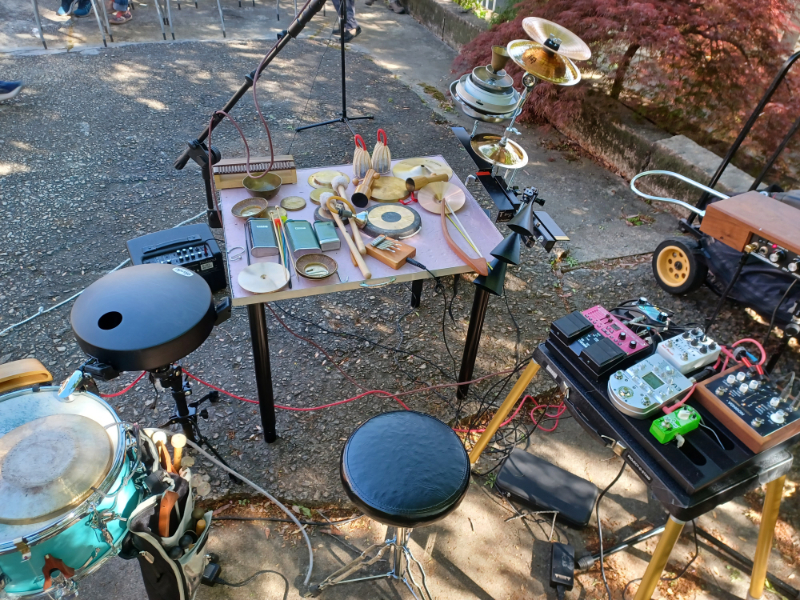April 6, 2024
Atlanta Contemporary
Atlanta, GA – USA
“Ear Pollen”
Klimchak & Bob Stagner, percussion, electronics, etc.
Free improvization
Jon Ciliberto | 10 APR 2024
Artists are odd, weird even, and some proudly claim that description. It is surely odd to place a series of seemingly unrelated lines and colors — or sounds — together, in a way that nothing could predict in advance and that nothing can explain in retrospect. Musicians who freely improvise do that, by and large.
Local percussionist and multi-instrumentalist Klimchak’s Ear Pollen at the Atlanta Contemporary is a performance series that pairs him with other musicians in improvisatory duets. Another avant-garde veteran joined him this last Sunday in the April sunshine for a well-attended, wide-ranging instant collaboration.
Bob Stagner is best known as the co-founder of free improvisation duo Shaking Ray Levis, but also has extensive experience as an arts educator with a lengthy and steady involvement in the Chattanooga, Tennessee community.
It was fascinating to watch the two work together, with each performer’s musical personality manifesting. Klimchak is a working musician, an ingenuous handyman who finds an idea to suit any situation, a problem solver whose mind is always working. Stagner, more outward-focused, spiritual, and quixotic, threw out ideas less with a definable goal in mind. Both strategies complemented one another and produced interesting, often beautiful results.
The performance was divided into two large sections, but within each, many distinct musical episodes appeared. I appreciated that both players knew both when to move on because a musical idea had run its course, but also when to move on when one wasn’t catching hold. These two kinds of sensitivity are really crucial to successful improvisation.

Klimchak and Steger in performance at the Atlanta Contemporary, April 6, 2024. (credit: Terry Kearns)
The first section, roughly 18 minutes in length, was a bit more feeling-out than the second (about 20 minutes). Initially, then, the music was perhaps less thematic, more idiomatic in terms of “free improvisation.” Despite the name, free improvisation has its own manifest rules. That’s right: free improvisation is not free!
Expectation for something born in the moment is a strange state of mind, as is reviewing such things. Free improvisation is a musical form born in the 20th century from both the natural progression of jazz and the European avant-garde. It is an open question whether an experiment first conducted more than 50 years ago is still an experiment today.
Somewhat more thematic play appeared in the second half. A spacious, open segment of gongs and bells initially proceeded into gently warbling electronic processes: some lovely moments between rumblings, wind, and green trees against the blue sky.
Both players used looping pedals to create occasional bases for overlay playing. Even though both are primarily drummers, the music rarely fell into a locked rhythmic groove. The instances when it did sounded out a funky junkyard tribalism. Both players also had microphones fed into various electronic processing. However, electronics were not the dominant voice: mostly, what was heard was what was struck, scraped, bowed, or voiced. I appreciated that as well.
Prior to show, the audience members examined each musician’s gear: the instruments and devices each selected for improvisation were a bit of a key, or a set of parameters. Segments of musical improvisation were often started quite directly from one performer (more often Klimchak — he also had a far wider assortment from which to choose) switching to a new instrument and thus suggesting something to the other.

Klimchak’s instruments. (credit: Jon Ciliberto)

Stagner’s instruments. (credit: Jon Ciliberto)
After the performance, looking out over the large and appreciative audience, Terry Kearns, ever wide-eyed, positive, and in love with every moment of art, said: “I like it because it’s so odd, and [because] everyone here is so old.” The audience was of a certain age, in the ballpark of the performers, and the continuity and community of interest in this type of art is a key aspect of it. Whether or not free improvisation continues as a meaningful art form well into the 21st century is unclear. Yet artists will always be weirdos, art-making into the later years, seeking odd, still surprising, but ever dear sounds. ■

Illustration of Klimchak and Stagner by Jon Ciliberto.
EXTERNAL LINKS:
- Klimchak: klimchakmusic.com
- Shaking Ray Levis: shakingray.com
- Atlanta Contemporary: atlantacontemporary.org

Read more by Jon Ciliberto.
RECENT POSTS
 From pagan ritual to Biblical trial: Spano and ASO explore theme of sacrifice in Stravinsky’s “Rite” and Leshnoff’s “Isaac” • 18 May 2024
From pagan ritual to Biblical trial: Spano and ASO explore theme of sacrifice in Stravinsky’s “Rite” and Leshnoff’s “Isaac” • 18 May 2024 Musical homecoming: ASYO’s 50th-anniversary concert gathers participants from the orchestra’s beginnings to the present • 16 May 2024
Musical homecoming: ASYO’s 50th-anniversary concert gathers participants from the orchestra’s beginnings to the present • 16 May 2024 Chang and Beck’s “Sonatas & Myths” illuminates distinctive styles of Szymanowski, Dohnányi, and Bartók • 14 May 2024
Chang and Beck’s “Sonatas & Myths” illuminates distinctive styles of Szymanowski, Dohnányi, and Bartók • 14 May 2024





.png)